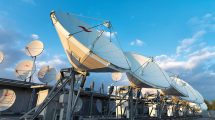 The digital oilfield has been evolving for over 30 years, driven by developments in software and smart hardware designed to improve operational efficiency, optimisation, decision-making, collaboration and integration into production planning. High-performance satellite networks help the oil & gas industry develop new modes of operation by providing supervision of drilling and production, instant collaboration with support staff located anywhere on the globe, efficient utilisation of manpower and monitoring of critical processes.
The digital oilfield has been evolving for over 30 years, driven by developments in software and smart hardware designed to improve operational efficiency, optimisation, decision-making, collaboration and integration into production planning. High-performance satellite networks help the oil & gas industry develop new modes of operation by providing supervision of drilling and production, instant collaboration with support staff located anywhere on the globe, efficient utilisation of manpower and monitoring of critical processes.
Ronald van der Breggen, CCO, LeoSat Enterprises, says: “High-speed data links to operating bases, along with data sharing among numerous stake holders and video-enabled services, allows operating bases to be connected in real time to the control room in the field and have access to any number of remote experts around the globe.”
Providing rig workers with the communications capabilities to help improve safety goes a long way to achieving health and safety goals. At the same time, providing business tools that deliver reliable connectivity to enable them to communicate with headquarters and supply chain partners, and to carry out regular business-related activities even when out of reach of alternative networks, helps make day-to-day activities proceed more smoothly.
Gavan Murphy, Director of Marketing, EMEA at Globalstar, says: “Reliable, resilient connectivity also helps alleviate the stress we all experience when we need to make an urgent call or send a vital email, yet no matter how hard we try, we simply can’t get a stable Wi-Fi or 3G/4G signal. To add to the safety imperative, access by the emergency services while on a rig at sea requires specialist support such as an air ambulance. All told, remote crew require a communications system they can trust, rain or shine, 24/7, and that enables an always-on link with colleagues on land. And when there’s an emergency, crew need to know they can summon rescue.”
“A satellite-based communications solution offers the only viable communications lifeline. Being able to stay in touch with home boosts morale and welfare among crew who are away for extended periods of time. They need an easy way to call friends and family which is low-cost, so they don’t feel they need to wait for a special occasion to make contact.”
So, how has the drop in oil prices changed the satellite industry? Even though communications are essential, are companies looking for cheaper communications?
According to Shahrokh Khanzadeh-Amiri, Director of Sales, Middle East and North Africa, Intelsat, it’s too early to call a bottom, but with price hovering around $50 per barrel, he is seeing some segments returning to production and starting to think about how to support new operations.
He says: “The energy sector depends on satellite for critical commercial infrastructure in both boom times and during periods of uncertainty, especially as the search for new sources of energy takes operations to more and more remote locations on land and at sea. Efficient, cost-effective communications support critical applications, and while operating costs are a consideration, ultimately the choice in network infrastructure comes down to three things: consistent performance even in remote areas, scalable throughput in high-demand areas, and resiliency and security to provide confidence in daily operations.”
Michael Manson, Sales Manager at Telenor, thinks that, like all aspects offshore, the price of communications is continually being assessed to find the most cost-effective solutions.
He says: “This need to reduce costs has led to the oil & gas industry being more receptive to new innovative ideas and technologies which would help achieve savings. Given the downturn in the industry and availability of personnel crew, welfare is not as high a priority as when availability and retention of skilled staff was paramount. Crew welfare would typically be addressed through the provision of a separate low-cost contended solution. Ka-band and Thor 7 would provide an ideal solution for crew welfare due to the low cost and smaller antenna needed.”
Van der Breggen goes further to say that clearly the collapse of this industry, which has taken 440,000 jobs in the process, has had an impact on the investment dollars spent on data-communication services. Though the market is bouncing back, Bloomberg predicts that only a half to two thirds of those jobs will come back, due to more efficient drilling rigs and increased automation.
“So while things may be bad now, for telecommunication companies the oil & gas market will come back with a vengeance. Requests for bandwidth will be higher than ever before, and that brings us to pricing. With new capacity coming online driving prices down, the increase in demand might offset that to a certain degree.
“What is however very clear is that the highest quality bit, i.e. low-latency, high-capacity, ultra-secure and easy to set up anywhere in the world, will be the bit that is least affected by any price pressure. At LeoSat, we are confident that we have that highest quality bit and therefore never have to lead any downward price spiral. We simply have too many unique and valuable attributes when compared to either fibre or any type of HTS satellite, particularly for oil & gas.”
Kevin McCarthy, VP of Market Development, Newtec, thinks most IT departments are under pressure to control costs, even as demand for bandwidth continues to grow as a result of data and crew welfare applications. He feels the key is for service providers to have an offering that minimises costs while maximising availability, efficiency, scalability and flexibility.
“Crews rely on cost-effective, dependable, high-speed communications to access their preferred internet services and stay in touch with family and friends. For this, it is vital to have a highly efficient and flexible VSAT platform which minimises capacity costs and enables service priorities to be adapted on the fly, depending on available bandwidth,” he says.
Murphy says there is unlikely to be wholesale abandonment of satellite communications networks, even in the face of unstable oil prices. The business benefits of satellite communications are clear and overarching, and no real alternatives can deliver comparable capability.
“We in the satellite industry have for many years been motivated to develop flexible and highly capable solutions, often involving multiple technologies, which deliver the maximum value for money for our customers. From the Globalstar point of view, we have seen game-changing innovation from our worldwide network of value-added resellers. They have successfully teamed satellite communications with other technologies including GSM, GPRS, RFID and other kinds of network architecture to deliver seamless multi-technology networks which use least-cost routing. These hybrid solutions are delivering long-term value.”
Moving Forward
Looking forward, McCarthy says that in the oil & gas context, the combination of increased M2M connectivity from smart pipelines and the shifting nature of crew communications towards video-based applications means satellite solutions need scalability that caters for all requirements, from a few sites on a traditional satellite beam to global networks serving thousands of sites across different beams or satellites.
In order to enhance the role of satellite in oil & gas, what is required is “availability, efficiency, scalability and flexibility which is crucial for the oil & gas sector, and this can be achieved with a unique combination of satcom technologies like those onboard our Newtec Dialog platform. These satellite technologies, such as DVB-S2X, Mx-DMA, FlexACM, clean channel technology and cross-layer optimisation, can generate bandwidth savings. In addition, they provide the options of prioritising services on the fly and reliable and efficient datacasting.”
Manson says the industry faces an oversupply of capacity in certain regions, which has forced prices down dramatically over the past 24 months. In addition, VSAT faces competition from 4G and LTE services in areas such as the GoM, North Sea. New MEO constellations and future LEO services also add uncertainty to the future of traditional GEO satellite services.
Manson says: “New satellites and hardware are allowing higher data rates and more information to be transferred between offshore installations and onshore bases.
“New technologies and extended coverage through such initiatives as polar orbiting satellites need to be considered when oil and gas prices rise and exploration commences in the Arctic regions, which cannot be serviced by traditional GEO satellites.”
Speaking on industry challenges, Amiri says cyber threats continue to increase, and the oil & gas industry faces a high degree of risk due to the nature of the business as well as growing use of bandwidth by crew, which can introduce access points to a network not related to corporate operations.
“We have to consider all of the applications being used on the network, and every part of the hybrid networks that serve remote operations will need to be secured for our customers. Intelsat understands the importance of securing a network in order to protect the valuable data being exchanged. We have invested considerable resources building a strong cyber posture, because our role in the world’s infrastructure is very far reaching and our customers receive this security overlay as part of the services we provide.
“With the oil & gas sector increasingly relying on an always-on connectivity, the satellite industry must work on ensuring easier access to the technology, enhanced performance that responds to these growing requirements and better economics. Our efforts need to be focused on maximising satellite’s traditional advantages of reach, ubiquity, reliability, point to multi-point capabilities and security, while delivering higher performance paired with better economics.”
Van der Breggen thinks a very common challenge in increasingly modern rigs is that they produce enormous amounts of data to ideally be reviewed in near real time. Up to now, transportation of the data for analysis has traditionally been through either daily helicopter flights back to operations sites or by connecting to a satellite network. Transporting data daily via helicopter incurs very high costs, and existing satellite networks cannot handle the bandwidth and speed requirements to move large amounts of data quickly.
“The challenge of data transportation and connectivity in the oil & gas sector has been resolved with the development of a unique low-Earth orbit data network solution which combines the speed of fibre with the ubiquity of satellite. Conceived by two former Schlumberger executives with a long history of working with the challenges of data transportation in the energy sector, LeoSat’s data network is comprised of a constellation of up to 108 low-Earth orbit communications satellites, all interconnected through laser links, creating an optical backbone in space which is about 1.5 times faster than terrestrial fibre.
“Using optical inter-satellite links and operating in polar orbits at an altitude five times closer to Earth than MEO and 25 times closer than GEO allows LeoSat to provide an ultra-low latency, high-throughput and global data network. This advanced system architecture is also able to encrypt and logically separate the data as it flows through the system, providing secure end-to-end communications with no terrestrial touch points,” says van der Breggen.
In conclusion, van der Breggen says the world in general is increasingly inter-connected, cloud-based and data-driven, and this is equally important for the oil & gas sector. Bandwidth requirements continue to rise with the demand for always-on connectivity, and operators continue to look at how satellite technology can improve operational efficiency.
“Oilfield operators will benefit from a network that is not only completely secure and reliable, but delivers data faster than on any terrestrial or satellite network. Combining the speed of fibre with the ubiquity of satellite means LeoSat is creating a new satellite paradigm, shifting the role of satellites in the oil & gas sector from a last resort option to a first choice for data transportation,” he concludes.












Add Comment